I’m nearly out of bacon lard and need to make some more, so I figured it was a opportune time to write a tutorial on just how I do that.
Just a word about using lard: if you are vegetarian or subscribe to the low-fat-everything-is-healthy-for-you way of eating, then this is not a post for you. If you’d like to learn more about the philosophy I believe when it comes to using saturated fats for our family’s diet, read this article, it sums up my beliefs quite well.
Now, I’ll be the first to say that the lard which comes from processed bacon is not the healthiest fat on the planet. But I use it because 1.) saturated fats are not the evil fats they have been made out to be, and 2.) (most importantly) it’s free! As with almost everything in this world, moderation is key. I suppose it would be more healthy if we used healthier bacon (yes, there is such a thing.) But we haven’t made that switch yet. One of these days…
So, what is bacon lard anyway, and how do you make it?
I’m so glad you asked. ‘Cause I’m gonna tell you. 🙂
Whenever you make bacon, there’s all that grease left over, right? I know some people dump that grease into a grease pot and leave it on the counter and use it just like that. But, my modern food handling mind just can’t get past that. And I know people who simply pour their bacon grease in a container and keep it in the fridge and use it as needed. I don’t like that either because then you have all those little burned bits of bacon fond mixed in with the grease and an overpowering bacon flavor. I know, I know, there are those of you asking, “What’s wrong with that???”(My Hubby is included in your ranks, for sure!) But depending on what I’m using it for, I don’t want it to taste so much like bacon. And those little burned bits just make the grease look “dirty”. Turning your bacon grease into bacon “lard” makes it nice and clean and less bacony in flavor. It is a long, but very simple process. Most of the time you’re not doing anything but waiting for the grease to harden.
Ok, you you’ve just made your bacon and you want to clean the pan. What do you do with the grease? Well, you simply pour it into a container and put it in the fridge.
But wait! Didn’t I just say I don’t like doing that? No, I said I don’t like using that grease as-is. I do something extra with the grease to make it more like lard.
First of all, I like to strain my grease through a paper towel as I put it in the jar.

This step is not totally necessary, but makes the cleaning process go faster.
Cleaning process? You “clean” your lard?
Yep. Yep I do.
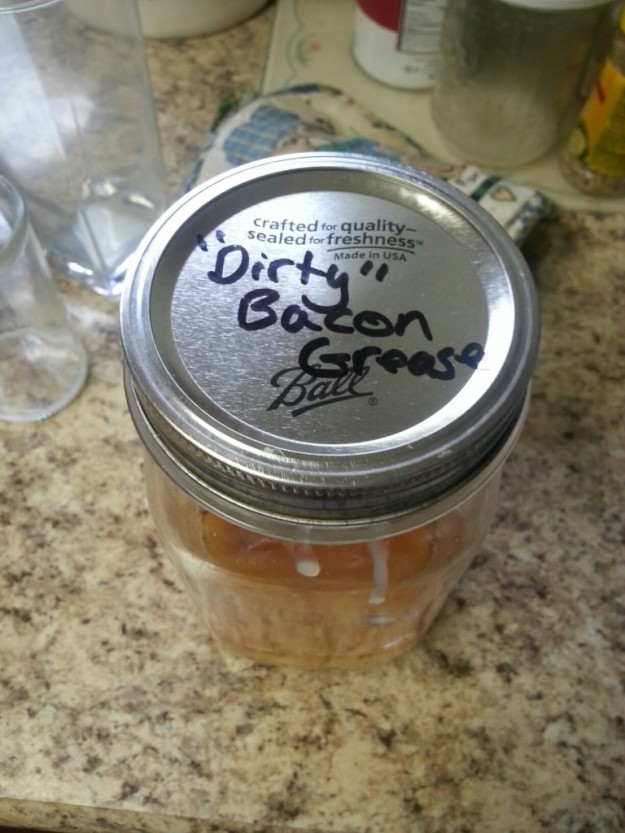
Anyway, once your container is full (or nearly so – this make take a while depending on how often you eat bacon), simply melt your grease…
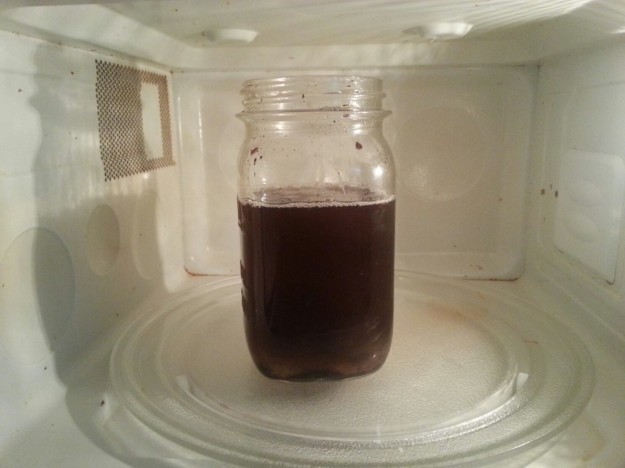
Yes, that’s bacon grease – with all the dirty bits still inside.
…I use the microwave.
Then you add the grease and about the same amount of water into a pot and put it on the stove to boil.
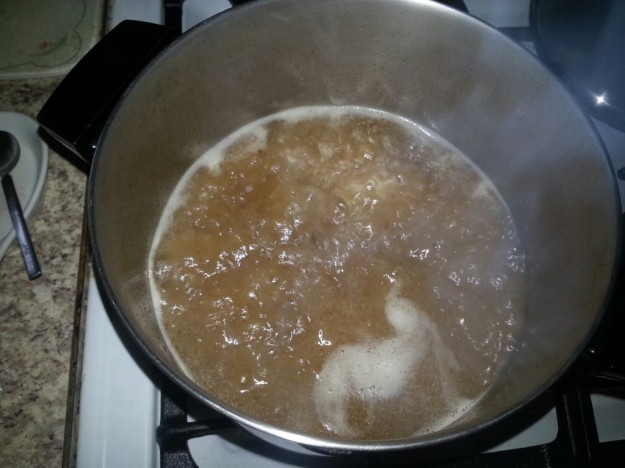
Once it just starts to boil, turn it off and set it aside. You can put in some cold water to help it cool off faster. As I’m sure you know, oil and water do not mix. The lard (oil) will float to the top of the water, and the impurities which were in the grease (the dirty bits) will sink or be washed out by the water.
The next step is where the length comes in. You have to let this oil and water concoction cool enough that the fat will solidify. If the temps are cold enough outside, I often secure the lid on the pot, and put it outside in the cold. This makes the process go faster. However, if the temps outside are too high, I let it cool to room temperature, then stick it in the fridge, usually overnight.
Once the fat has solidified, scoop it out with a slotted spoon and put it into a bowl.
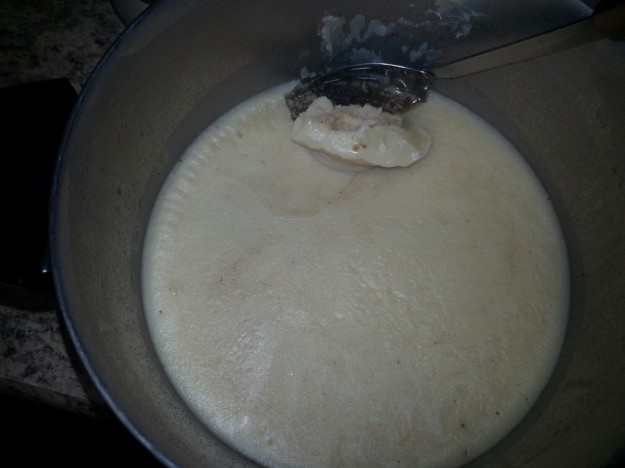
scoopable-solid again

Look how dirty the water is
Once you get all the chunks of fat out (I use a small mesh strainer to get all the little bits), you’ll be left with dirty water which you can pour down the drain.
I usually “wash” the grease a couple more times by following the above steps, until the water is clear underneath the solidified fat.
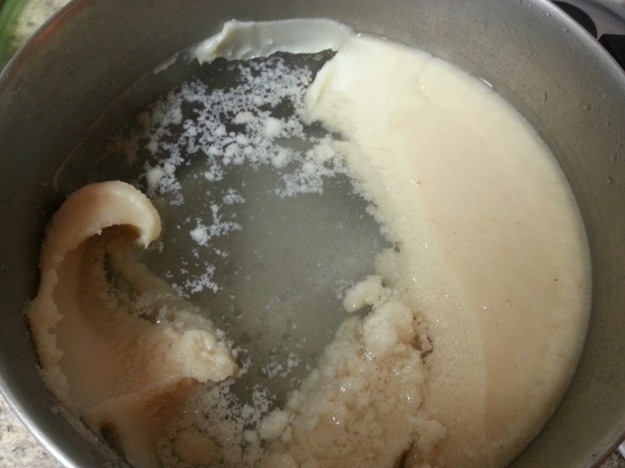
Clear water
But you could certainly skip the subsequent washings if you wanted. I find that by filtering the grease through a paper towel first, it takes fewer “washings” to get the lard as clean as I like it.
Once it’s as clean as you want it, you scoop the grease into a bowl with a slotted spoon or mesh strainer (try to let as much water drip from it as possible).
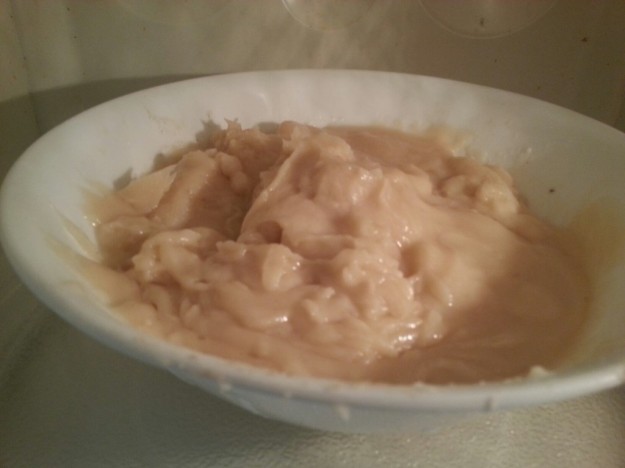
Clean lard
Melt the lard just until pourable and pour into mason jars*.
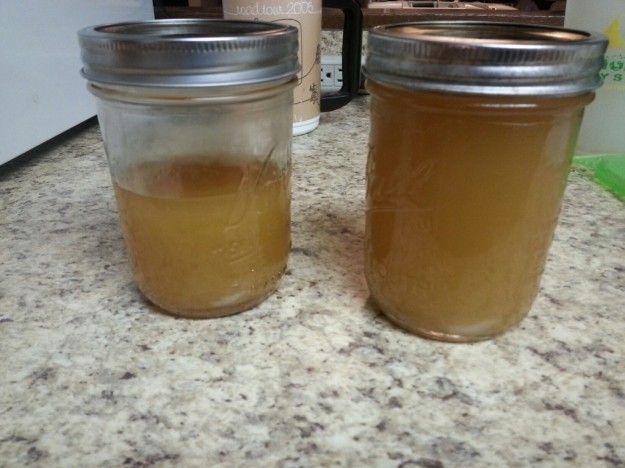
Notice the color change from the first time I microwaved it near the top of the post.
I suppose there’s probably some way to process this so that it is shelf stable. But I have never researched it. I just stick it in the fridge once it’s cooled off a bit (or freezer if I have extra).
Note: once it has solidified, you might find that there is some water in the bottom of the jar.

If this happens, slide a knife along the glass into the lard in two spots on opposite sides of each other. Then pour the water out one of the holes (the other hole is to allow air into the bottom cavity so the water flows easier.)
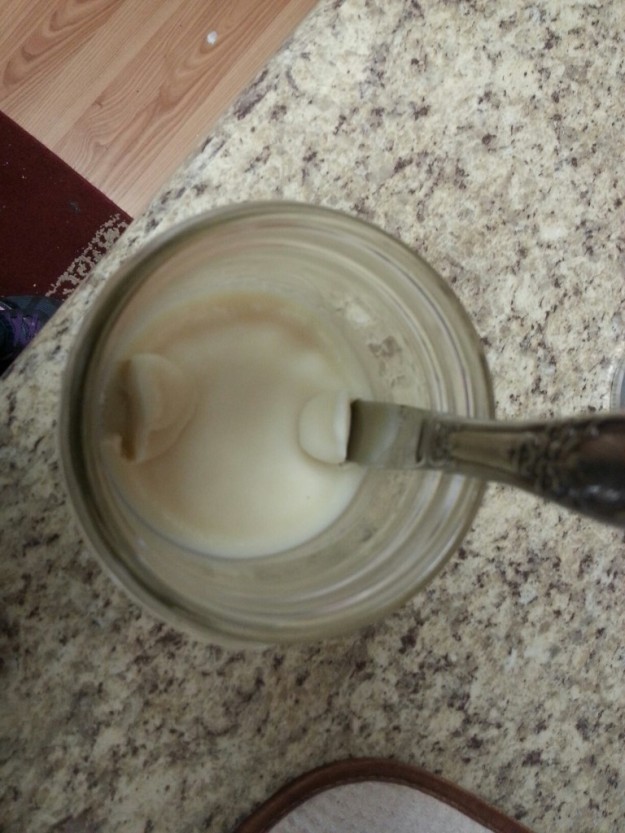
If you prefer, you can heat the grease again so it melts and fills the holes back in.
*I always use wide mouth pint jars because they are the perfect size for our favorite spatula to fit in to scoop out a bit of lard (not an affiliate link – we just really like the style. In fact, we happened to find some at the dollar store!).
So there you have it. Now that your bacon grease has become lard, you can use it in much the same way you do regular lard. I do find it still has a bit of a bacon flavor/odor, but it is only objectionable to use it in things that are naturally bland themselves. I have even made soap with it!
I always feel so frugal when I use my bacon lard. I mean, it is basically free since you’re gonna eat the bacon anyway, right? So now you have something useful to do with the left over grease.


I have done it almost the same way as you have and end up with creamy white lard – so good to cook with! And I agree that saturated fats from pastured animals is not bad for you! As humans, we NEED fats! I have also made soap from bacon lard, and contrary to popular belief, after purifying the lard using the process you described, the soap does not smell like bacon because the lye chemically changes it a bit! Thanks for sharing your process!
LikeLike
Thanks for your comments, Vickie! It’s great to know others out there who do the same things. 🙂
LikeLike
Very interesting!! I save bacon grease the dirty way, in a jar in the fridge, but I don’t use it very often, so my jar stays full. So I end up throwing grease out a lot, and I always feel so wasteful! Maybe I’ll designate a second jar for it and save more and try this process. Thank you for sharing it!
LikeLike
If ever I have more than one jar of processed lard, I put it in the freezer. I figure it will last in there FOREVER. And then if I ever run out before I have enough grease or time to make more, I can pull the frozen jar out. 🙂
LikeLiked by 1 person
Very smart! I really like the idea of making in into clean lard. Will definitely be trying it out!
LikeLiked by 1 person
Pingback: The daily life of an urban homesteader | Castle Rock Homestead
My grandmother always cooked with bacon lard. It makes the most delicious fried cabbage!
LikeLike
Oooh, fried cabbage. I’ll have to try that!
LikeLike